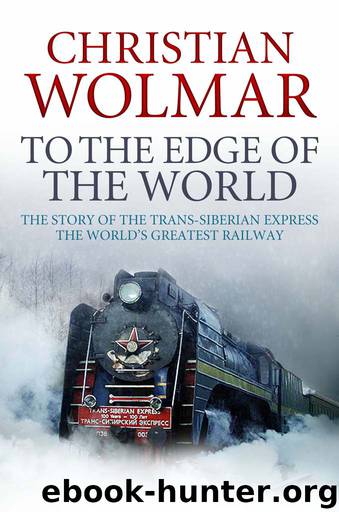To the Edge of the World by Christian Wolmar

Author:Christian Wolmar
Language: eng
Format: mobi
ISBN: 9781782392040
Publisher: Atlantic Books Ltd
Published: 0101-01-01T00:00:00+00:00
SEVEN
THE NEW SIBERIA
While the railway may have been conceived by its principal promoters as an imperialist and military enterprise, the impact on Siberia was no less profound. For all its failings and inadequacies, the Trans-Siberian had a transformative effect on the region, beyond even the expectations of its most ardent supporters. The clearest change was the rapid increase in population, thanks to increased migration from European Russia. The Siberian migration was, according to its chronicler Donald Treadgold, the greatest movement of people in history up to that time, other than the arrival in the United States of vast numbers of Europeans during the nineteenth century. While the increase in Siberia’s population started before the railway was built, the pace of immigration rose dramatically as a result of its construction, and for a decade or so after the completion of the first section in 1896 there was a virtual stampede to settle in Siberia.
The railway allowed mass travel to Siberia for the first time, opening it up to colonization; it also changed the nature of the region, resulting in the population doubling between 1896 and 1921. As Harmon Tupper concludes, ‘The railway ran at a heavy loss to the Treasury; ordinary passenger trains were late, crowded and dirty beyond belief; the bulk of stationmasters, ticket clerks and train crews were given to slipshod ways and excessive drinking; but in enormous counterweight, the Trans-Siberian opened up the country and brought unparalleled benefits to hundreds of thousands.’1
Settlement of the region by emigrants from European Russia had always been a key part of the justification for its construction. The fact that the Committee for the Siberian Railway had been given control over the colonization process as part of its remit demonstrated that it was integral to the purpose of building the railway. Apart from construction of the railway itself, colonization occupied most of the Committee’s attention and, indeed, took up most of the rest of its expenditure. The Committee’s resettlement programme was based on a study of how Bismarck had attempted to ‘Germanize’ Prussia’s conquered Polish provinces through colonization. Other experiences of mass colonization in United States and Canada were also scrutinized for the lessons that could be gleaned. It was, in short, ‘demographic engineering on a mass scale’2 and it was devised by Anatoly Kulomzin, whom Witte had put in charge of managing the Committee and was also responsible for ‘auxiliary enterprises’, all the other tasks which the Committee had taken on, of which included the emigration process. Like Witte, Kulomzin came from a minor provincial aristocratic family and was a capable administrator, eager to modernize Russia, while retaining the system of absolute monarchy, and also like Witte, he had a long period at the heart of Russian government. Officially, he was the administrative secretary of the Committee of ministers, equivalent in modern British politics to the post of cabinet secretary. If Witte can be considered the architect of the railway, then Kulomzin was equally the guiding mind behind the resettlement programme.
The difficulties of developing a coherent policy in the context of such a conservative regime were legendary.
Download
This site does not store any files on its server. We only index and link to content provided by other sites. Please contact the content providers to delete copyright contents if any and email us, we'll remove relevant links or contents immediately.
| Africa | Americas |
| Arctic & Antarctica | Asia |
| Australia & Oceania | Europe |
| Middle East | Russia |
| United States | World |
| Ancient Civilizations | Military |
| Historical Study & Educational Resources |
Red Famine: Stalin's War on Ukraine by Anne Applebaum(2799)
Chernobyl by Serhii Plokhy(2417)
Midnight in Chernobyl by Adam Higginbotham(2365)
The House of Government by Slezkine Yuri(2088)
Midnight in Chernobyl: The Untold Story of the World's Greatest Nuclear Disaster by Adam Higginbotham(2056)
Red Shambhala by Andrei Znamenski(2050)
The Gulag Archipelago (Vintage Classics) by Aleksandr Solzhenitsyn(1964)
All the Kremlin's Men by Mikhail Zygar(1948)
From Cold War to Hot Peace by Michael McFaul(1927)
Red Notice by Bill Browder(1905)
Putin's Labyrinth(1879)
The Future Is History by Masha Gessen(1810)
From Russia with Lunch by David Smiedt(1783)
A People's Tragedy by Orlando Figes(1751)
The Romanovs by Simon Sebag Montefiore(1707)
How to Tame a Fox (and Build a Dog): Visionary Scientists and a Siberian Tale of Jump-Started Evolution by Lee Alan Dugatkin & Lyudmila Trut(1658)
Putin's Labyrinth: Spies, Murder, and the Dark Heart of the New Russia(1651)
The Lost Spy by Andrew Meier(1613)
Art and Revolution by John Berger(1591)
